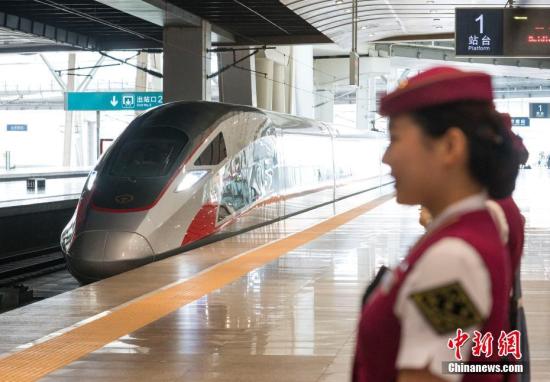


(Chinanews.com/Hou Yu)
China's latest generation bullet train, the Fuxing, will run on the Beijing-Shanghai high-speed railway starting from Sept. 21 at 350 km/h, China Railway Corporation (CRC) announced on Aug. 20.
The high-speed railway connecting Beijing and Shanghai is built to the world's highest standards, while the Fuxing is designed to run at a top speed of 350 km/h safely, reliably, and comfortably, said Lu Dongfu, general manager of CRC.
In 6 years of operation, the Beijing-Shanghai high-speed railway has carried over 630 million passengers. Currently, an average of 400-plus trains run on the rail each day.
The speed increase will better meet transportation demand by cutting travel time between the two cities by half an hour from five to four and a half hours, said an official with CRC. The speed increase is also expected to boost efficiency for enterprises.

(Chinanews.com/Hou Yu)
The Fuxing was designed and manufactured in China. The new bullet train model of China's Electric Multiple Units (EMU) has completed 600,000 kilometers of tests before it was approved to run on the Beijing-Guangzhou and Beijing-Shanghai railways in February 2017.
China has the largest high-speed rail network in the world, with a total track length of 22,000 kilometers and one third of that distance was designed and constructed for bullet trains with a top speed of 350 km/h, said He Huawu of the China Academy of Engineering.
He said there is a process for China to consider whether to speed up its whole high-speed network, though such a move could pose a challenge to railway management, noting that financial and social aspects must be considered.
The Fuxing, for example, would see energy consumption increase 20 to 30 percent if the train increased its speed from 300 km/h to 350 km/h. But whether other railways are suitable for the speed increase depends on infrastructure, demand, and economic factors, He said.
 Fire brigade in Shanghai holds group wedding
Fire brigade in Shanghai holds group wedding Tourists enjoy ice sculptures in Datan Town, north China
Tourists enjoy ice sculptures in Datan Town, north China Sunset scenery of Dayan Pagoda in Xi'an
Sunset scenery of Dayan Pagoda in Xi'an Tourists have fun at scenic spot in Nanlong Town, NW China
Tourists have fun at scenic spot in Nanlong Town, NW China Harbin attracts tourists by making best use of ice in winter
Harbin attracts tourists by making best use of ice in winter In pics: FIS Alpine Ski Women's World Cup Slalom
In pics: FIS Alpine Ski Women's World Cup Slalom Black-necked cranes rest at reservoir in Lhunzhub County, Lhasa
Black-necked cranes rest at reservoir in Lhunzhub County, Lhasa China's FAST telescope will be available to foreign scientists in April
China's FAST telescope will be available to foreign scientists in April "She power" plays indispensable role in poverty alleviation
"She power" plays indispensable role in poverty alleviation Top 10 world news events of People's Daily in 2020
Top 10 world news events of People's Daily in 2020 Top 10 China news events of People's Daily in 2020
Top 10 China news events of People's Daily in 2020 Top 10 media buzzwords of 2020
Top 10 media buzzwords of 2020 Year-ender:10 major tourism stories of 2020
Year-ender:10 major tourism stories of 2020 No interference in Venezuelan issues
No interference in Venezuelan issues
 Biz prepares for trade spat
Biz prepares for trade spat
 Broadcasting Continent
Broadcasting Continent Australia wins Chinese CEOs as US loses
Australia wins Chinese CEOs as US loses